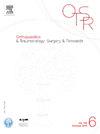Simple Hip Value: a simple score to evaluate Hip function
IF 2.3
3区 医学
Q2 ORTHOPEDICS
引用次数: 0
Abstract
Background
Several self-administered questionnaires are available for assessing hip function in clinical practice (HOOS-12, Oxford-12). These questionnaires can be used to assess and monitor patients with hip pathology. However, they are sometimes difficult to deploy in clinical practice. Recent studies on the shoulder and knee have shown that a single-question assessment provides a relevant evaluation of joint function, and correlates with more complex scores. However, this has not yet been evaluated for the hip. We set out to develop a single-question test that would enable patients to assess their hip function between 0 and 100. Therefore, we did a prospective study aiming to assess: (1) the relevance of the SHV (Simple Hip Value) test by comparing it with the Oxford-12 and HOOS-12 scores, (2) the discriminatory capacity and reproducibility of this test.
Hypothesis
The hypothesis of this study was that the assessment of hip function by a single-question patient-completed questionnaire (PROM) would be reliable and useful in clinical practice.
Patients and methods
We conducted a prospective study including 74 patients operated on for total hip arthroplasty from February 2020 to April 2021 in a high-volume center and 20 healthy subjects. The SHV questionnaire, as well as HOOS-12 and OXFORD-12 were submitted on average 18 months after surgery, with values scaled to 100 points. A second test containing the 3 questionnaires was resubmitted to 20 patients randomly chosen from hip arthroplasty group to evaluate the reproducibility of the test. To evaluate the discrimination capacity of our test, 20 controls were selected to respond to the three questionnaires.
Results
Test results were median SHV, Oxford-12 and HOOS-12 scores of 90/100 (Interquartile Range [IQR]: 80–95), 88.5 (IQR: 77.1–95.8) and 79.1 (IQR: 65.1–93.2), respectively. The SHV was strongly correlated with the Oxford-12 (Spearman coefficient: 0.63 [IQR: 0.45−0.76]) and the HOOS-12 (Spearman coefficient: 0.66 [IQR: 0.46−0.79]). The SHV differed significantly from the control group (90.0 vs 100.0 in the control group [p < 0.001]) and had excellent reproducibility (Interclass Correlation Coefficient [ICC]: ICC: 0.82 [CI95%, 0.59−0.93]).
Discussion
The SHV test seems to be a reliable, reproducible and discriminating tool for assessing hip function after total hip arthroplasty, thus offering a simplified and practical approach for practitioners. Further testing in different populations would be useful to validate this test.
Level of evidence
III; prospective comparative diagnostic study.
简单髋关节值:评估髋关节功能的简单评分。
背景:在临床实践中,有几种自填式问卷可用于评估髋关节功能(HOOS-12、Oxford-12)。这些问卷可用于评估和监测髋关节病变患者。然而,在临床实践中有时很难使用这些问卷。最近对肩关节和膝关节的研究表明,单个问题的评估可提供相关的关节功能评估,并与更复杂的评分相关联。然而,我们尚未对髋关节进行评估。我们的目标是开发一种单题测试,让患者能够在 0 到 100 之间评估自己的髋关节功能。因此,我们进行了一项前瞻性研究,旨在评估1)通过与牛津-12 和 HOOS-12 评分进行比较,评估 SHV(简单髋关节值)测试的相关性;2)该测试的判别能力和可重复性:本研究的假设是,通过患者填写的单一问题问卷(PROM)来评估髋关节功能在临床实践中是可靠和有用的:我们进行了一项前瞻性研究,研究对象包括 2020 年 2 月至 2021 年 4 月在一家高产量中心接受全髋关节置换手术的 74 名患者和 20 名健康受试者。术后平均 18 个月提交 SHV 问卷、HOOS-12 和 OXFORD-12,数值按比例为 100 分。为了评估测试的可重复性,我们从髋关节置换术组中随机挑选了 20 名患者,再次进行了包含这 3 份问卷的测试。为了评估我们测试的辨别能力,我们还选取了 20 名对照组患者对三份问卷进行回答:测试结果显示,SHV、Oxford-12 和 HOOS-12 评分的中位数分别为 90/100(四分位距:80 - 95)、88.5(四分位距:77.1 - 95.8)和 79.1(四分位距:65.1 - 93.2)。SHV与Oxford-12(斯皮尔曼系数:0.63(IQR:0.45 - 0.76))和HOOS-12(斯皮尔曼系数:0.66(IQR:0.46 - 0.79))密切相关。与对照组相比,SHV 差异较大(对照组为 90.0,SHV 为 100.0,SHV 为 100.0):SHV测试似乎是评估全髋关节置换术后髋关节功能的一种可靠、可重复和有鉴别力的工具,从而为从业人员提供了一种简化和实用的方法。在不同人群中进行进一步测试将有助于验证该测试的有效性:证据等级:III;前瞻性比较诊断研究。
本文章由计算机程序翻译,如有差异,请以英文原文为准。
求助全文
约1分钟内获得全文
求助全文
来源期刊
CiteScore
5.10
自引率
26.10%
发文量
329
审稿时长
12.5 weeks
期刊介绍:
Orthopaedics & Traumatology: Surgery & Research (OTSR) publishes original scientific work in English related to all domains of orthopaedics. Original articles, Reviews, Technical notes and Concise follow-up of a former OTSR study are published in English in electronic form only and indexed in the main international databases.

 求助内容:
求助内容: 应助结果提醒方式:
应助结果提醒方式:


